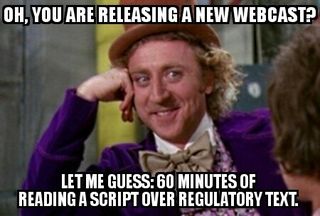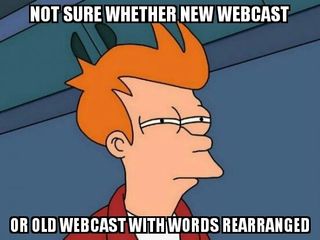We Listened So You Don’t Have To – CFPB’s Grab Bag of TRID Questions
Written by Brandy Bruyere, Director of Regulatory Compliance
If you're keeping count at home, the CFPB provided its eighth webcast on TRID this past Tuesday (second post-implementation of the rules). After listening to these sessions and getting the Bureau's "this informational only and not binding" disclosure so many times, it starts to feel a bit like this:
Or maybe this:
Or even this:
In all seriousness though, there is some helpful information here. The webcast addressed 21 different questions, so today I want to highlight two that NAFCU's regulatory compliance team received from members multiple times.
The second question in the webcast aimed to clear up confusion created by the closing handout that the CFPB distributed several months ago (we blogged about this issue here). The question Is an additional 3-business day waiting period required if the APR decreases by more than 1/4 or 1/8 of a percentage point, but the finance charge remains accurate? Here is an unofficial transcript of the CFPB's answer, with hyperlinks to citations added:
An APR would be considered accurate and a new 3 business day waiting period would not be required if the APR directly corresponds to a disclosed finance charge that is considered accurate. The APR tolerance rules are covered in section 1026.22 and it's important to note that the rule did not change these requirements. Section 1026.22(a)(4) contains special APR accuracy rules for mortgage loans and explains that in addition to the quarter or an eighth of a percentage point tolerance for accuracy, the disclosed APR is also considered accurate if the rate results from the disclosed finance charge and the disclosed finance charge would be considered accurate. Next slide please.
The tests for determining whether a finance charge is considered accurate are in sections 1026.18(d)(1) and 1026.38(o)(2) and explain that the disclosed finance charge shall be treated as accurate if it is understated by no more than $100 or is greater than the amount required to be disclosed. Thus as a general matter an overstated finance charge is treated as accurate. The finance charge is defined under section 1026.4 as the cost of consumer credit disclosed as a dollar amount. It includes any charge payable directly or indirectly by the consumer and imposed directly or indirectly by the creditor as an incident to or condition of the extension of credit. Some examples of finance charges include interest, points and loan fees. The rule did not change the definition of finance charge under TILA.
Because an overstated finance charge is considered accurate, an overstated APR that corresponds directly to an overstated finance charge would be considered accurate and an additional 3 business day waiting period would not be required. So in that case, consummation could proceed as scheduled. But, remember that not every overstatement of an APR is caused by an overstated finance charge. There may be situations where a decrease in APR would trigger a new 3 business day waiting period and consummation would be delayed. For example, if the finance charge was not overstated on the Closing Disclosure but the APR was overstated or decreased after issuance of the Closing Disclosure for reasons unrelated to the finance charge then the creditor would have to evaluate the accuracy of the APR with reference to the APR tolerances and not the finance charge tolerances. Similarly, if the disclosed APR exceeds the APR that directly corresponds to the overstated finance charge the creditor could not rely on the finance charge tolerances.
In both of these examples, if the disclosed APR exceeded the actual APR by more than 1/4 or 1/8 of a percentage point, it would be inaccurate under section 1026.22 and redisclosure with a new 3 business day waiting period is required by TILA. Don't forget that there's an additional APR tolerance for mortgage loans at section 1026.22(a)(5) which provides that an overstated or understated APR may also be accurate if the disclosed APR is closer to the actual APR than an APR calculated based on the disclosed finance charge would be. I would also note that in the August 2014 webinar we discussed APR accuracy under section 1026.22 and changes before consummation requiring an additional 3 business day waiting period under section 1026.19(f)(2)(ii). I encourage our listeners to review those materials.
Another question addressed in the webcast discussed having a negative amount for the owner's title insurance policy, particularly where there is a discount for simultaneous issuance of the owner's and lender's title policies. In these cases, TRID's formula for disclosing the owner's title insurance premium can yield a negative number. This is a question that has caused problems for many credit unions and while the CFPB informally and verbally clarified that disclosing a negative number is acceptable, there was no formal guidance on this point until Tuesday. Here's the question with an unofficial transcript of the answer:
Q7: The calculation of the owner's title policy premium in accordance with the rule might result in a negative number. Does the creditor disclose this negative number for the owner's title policy on the Loan Estimate and Closing Disclosure?
Yes. In this case, the creditor discloses the premium for the owner's title insurance policy as a negative number. When the simultaneous issuance rate or discount is used, mostly in purchase transactions, the cost of an owner's title insurance policy is disclosed as the incremental cost of that owner's title insurance beyond the standard non-discounted cost of the lender's title insurance policy. Comment 37(g)(4)-2 states that the owner's title insurance premium is calculated by taking the full owner's title insurance premium, adding the simultaneous issuance premium for the lender's coverage and then deducting the full premium for lender's coverage. We've previously discussed in detail how a creditor calculates these premiums in the May 2015 webinar which I encourage our listeners to revisit.
The calculation of the premium for the owner's title policy as required under the rule may result in a negative number. When this occurs, the creditor discloses a negative number as the incremental cost of the owner's title insurance policy. When disclosed in this fashion, the disclosure conveys to the consumer that it is less expensive to purchase both owner's title insurance and lender's title insurance together than it is to purchase just lender's title insurance by itself. There are no provisions in Regulation Z that would prohibit the cost of owner's title insurance from being disclosed as a negative number.
Other questions address topics like calculating the Total Interest Percentage, making certain flood insurance premium disclosures, disclosing transferred escrow funds in a refinance transaction, providing the seller's Closing Disclosure, disclosing seller-paid costs including real estate fees, and handling principal curtailments. We'll highlight a couple of these other questions in a future blog post.
***
FLSA: Information You Need to Know
Live Webcast, Wednesday, April 20 | 2:00 p.m. - 3:30 p.m. EST
 Part of the Human Resources Webcast Series
The Fair Labor Standard Act (FLSA) is a tricky field than many suspect, with many rules and regulations involved. Join this informative webcast to ensure that you're correctly classifying your staff and understanding all aspects of the law fully. You'll cover upcoming regulations and how they impact your credit union. You'll also explore claims and lawsuits, exemption categories and learn best practices. Gain a better understanding of FLSA and explore ideas to implement at your credit union.



